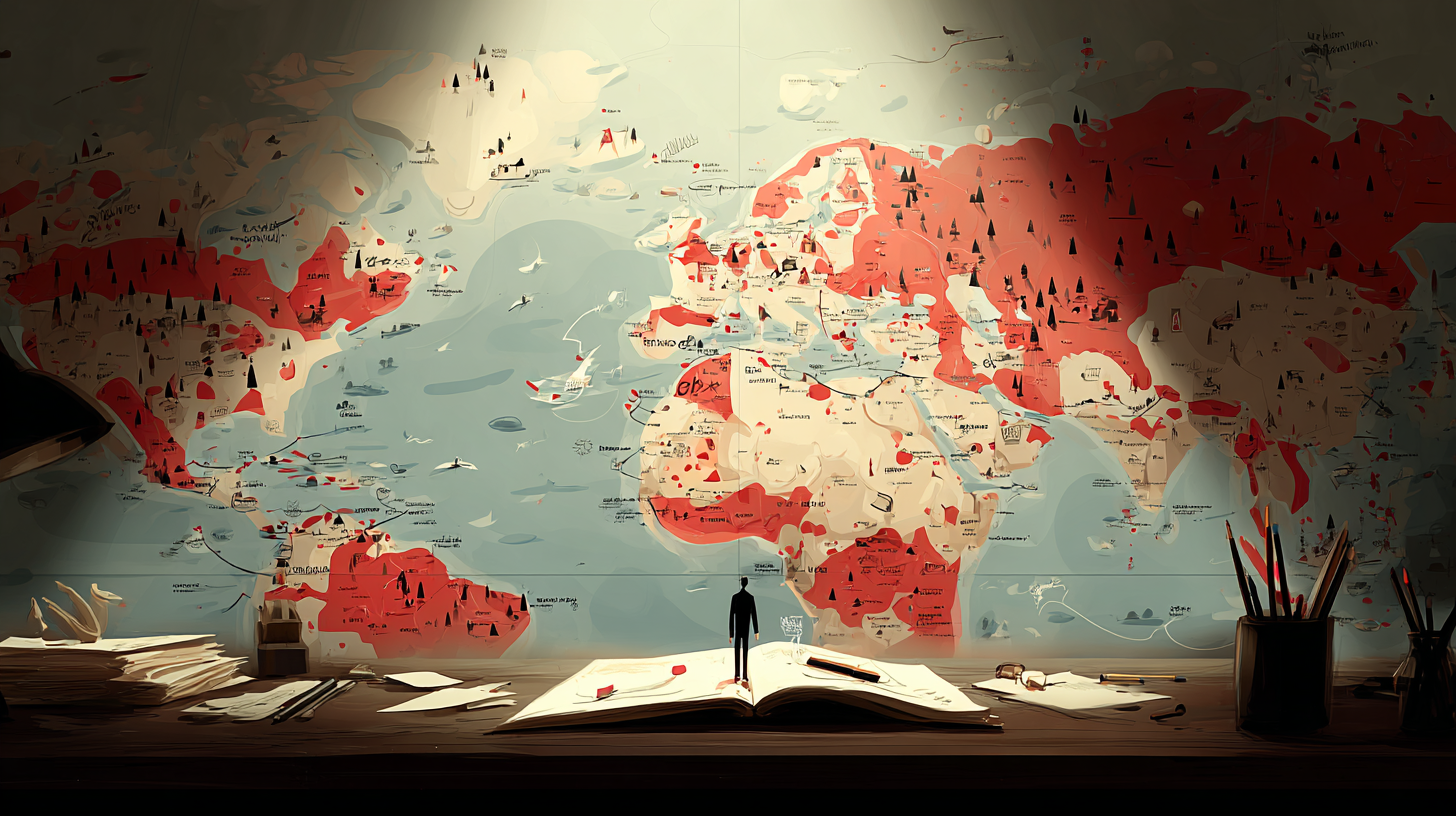map means “a picture that shows places” or “to make a plan.”
map は「場所をしめす図」や「計画を立てること」をあらわす言葉です。
以下は英単語 “map” に関するストーリー型学習コンテンツです。まずは大枠の意味を理解して最後の文章で確認しましょう。
主な意味(main meaning)
| 品詞 | 発音 | 意味 | 英語例文 |
|---|---|---|---|
| 名詞 | /mæp/ | 地図 | He looked at the map to find the station. |
| 動詞 | /mæp/ | 地図を作る、計画する | Scientists will map the ocean floor. |
語源(etymology)
「map」はラテン語 mappa(布、ナプキン)が語源。昔は布に絵を描いて地図を作ったことから、現在の「地図」の意味になりました。核のイメージは「広がる場所を表すもの」。
類義語(synonyms)
| 類義語 | 意味 | 英語例文 |
|---|---|---|
| chart | 図表、海図 | The captain checked the chart before sailing. |
| plan | 計画 | We made a plan for our summer vacation. |
| diagram | 図、図解 | The teacher drew a diagram on the board. |
| guide | 案内、手引き | This guide will help you explore the city. |
反義語(antonyms)
| 反義語 | 意味 | 英語例文 |
|---|---|---|
| chaos | 混乱 | Without a map, the trip turned into chaos. |
| confusion | 混乱、混同 | She felt confusion when she saw the signs in a foreign language. |
コロケーション(collocations)
| コロケーション | 英語例文 |
|---|---|
| world map | I bought a world map for my room. |
| road map | The driver used a road map to find the village. |
| treasure map | The children followed a treasure map in the game. |
| map out a plan | We need to map out a plan for the project. |
2項表現(binomials)
| 2項表現 | 英語例文 |
|---|---|
| trial and error | He learned the route by trial and error. |
| here and there | Maps show parks here and there in the city. |
英語ストーリー(english story)
Short Story: The Office Project
Kenji had just started working at an international company in Tokyo. One day, his boss gave him an important task.
“Kenji, we need to make a new guidebook for our foreign clients. It must include a world map and a road map of the area around our office,” she said.
Kenji looked at the big map on the wall and thought about how to organize the project. He knew that if he wanted success, he needed to map out a plan carefully. His idea was to make different sections: restaurants, hotels, transportation, and sightseeing spots.
At first, the task seemed easy, but soon he realized it was not. When he checked the information, there was so much data that he felt confusion. Some places had closed, and others had moved. If he didn’t organize it well, the guidebook would turn into chaos.
So, he decided to use a chart to sort the information. For example, in one column he wrote the names of hotels, and in the next column, the prices. Then, he drew a diagram to show how to move from the office to the nearest station.
But that was not enough. Kenji also wanted the guidebook to be useful, so he made a small plan for each day a visitor might stay. He included a map of a local park, where visitors could see flowers here and there, and a treasure map style illustration for children.
His colleague, Aya, saw his work.
“You really learned this by trial and error, didn’t you?” she said with a smile.
“Yes,” Kenji laughed. “At first I was lost, but now I think I made a real guide for our clients.”
Finally, when Kenji showed the guidebook to his boss, she was impressed.
“This is excellent, Kenji. You didn’t just copy a map. You mapped out a plan, and you made it simple and clear. Our clients will be very happy.”
Kenji felt proud. He understood that a map was not only a picture of places, but also a way to make a clear path through confusion.
和訳
ケンジは東京の国際企業で働き始めたばかりでした。ある日、上司が重要な仕事を任せました。
「ケンジ、外国のお客様向けの新しい案内冊子を作る必要があるの。**world map(世界地図)と、オフィス周辺のroad map(道路地図)**を入れてちょうだい。」
ケンジは壁にかけられた大きな**map(地図)を見ながら、どうやってこのプロジェクトをまとめるか考えました。成功するには、注意深くmap out a plan(計画を立てる)**ことが必要だと感じました。
最初は簡単に思えましたが、すぐに難しいと気づきました。調べてみると情報が多すぎて**confusion(混乱)しました。閉店している店もあれば、移転しているところもありました。うまく整理しなければ案内冊子はchaos(大混乱)**になってしまうでしょう。
そこで彼は情報を整理するために**chart(表)を使いました。例えば、一つの列にホテルの名前を、次の列に値段を書きました。そして、会社から最寄り駅までの道順をdiagram(図)**で描きました。
しかし、それだけでは十分ではありませんでした。もっと便利にするために、滞在日ごとの小さな**plan(計画)も作りました。例えば、公園のmap(地図)を入れて、花がhere and there(あちこち)に見られることを紹介したり、子供向けにtreasure map(宝の地図)**風のイラストも描きました。
同僚のアヤが彼の仕事を見て言いました。
「これ、本当に**trial and error(試行錯誤)で作ったんだね。」
「うん、最初は迷ったけど、今は本当にお客様向けのguide(案内)**になったと思うよ。」
最後に、ケンジが上司に冊子を見せると、上司は感心しました。
「素晴らしいわ、ケンジ。単に地図をコピーしたんじゃない。計画を立てて、シンプルで分かりやすくしてくれた。お客様はきっと喜ぶわ。」
ケンジは誇らしい気持ちになりました。**map(地図)**は単なる場所の絵ではなく、混乱から道を見つける方法でもあると理解したのです。
Q&A
Q: mapとchartの違いは何ですか?
A: mapは地理的な場所を示す「地図」を表します。chartは海図やグラフのように、特定のデータや情報を整理して示す図に使われます。
Q: mapとplanはどう違いますか?
A: mapは「場所を示す図」ですが、planは「計画」や「未来の行動の設計」を指します。mapは空間的な情報、planは時間的な流れや行動の内容を表すことが多いです。
Q: mapとdiagramはどう違いますか?
A: mapは実際の地形や場所を示すものですが、diagramは仕組みや関係性を説明するための図です。例えば、電気回路や人体の構造を説明するときにdiagramを使います。
Q: mapとguideの違いは?
A: mapは「場所を示す図」ですが、guideは「案内」や「手引き」です。guideは人や本、ウェブサイトなどで使われ、必ずしも図でなくても「方向を示す役割」を果たします。
Q: mapとworld mapは同じですか?
A: world mapは「世界全体を示す地図」で、mapの一種です。mapはもっと広い意味で、町の地図や観光地図なども含みます。
Q: mapとroad mapはどう違いますか?
A: road mapは道路に特化した地図で、運転や移動に便利です。mapはもっと一般的な地図全般を指します。
Q: mapとtreasure mapの違いは?
A: treasure mapは宝探しのための特別な地図で、物語やゲームによく登場します。mapは現実的・実用的な意味で使うことが多いです。
Q: planとmap out a planの違いは?
A: planは「計画」ですが、map out a planは「計画を詳しく練る」というニュアンスがあります。単なる計画ではなく、道筋をはっきりさせるイメージです。



コメント